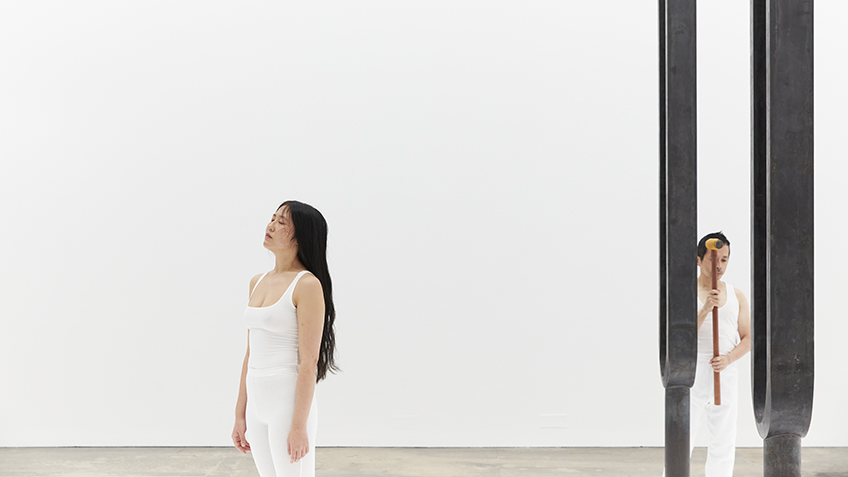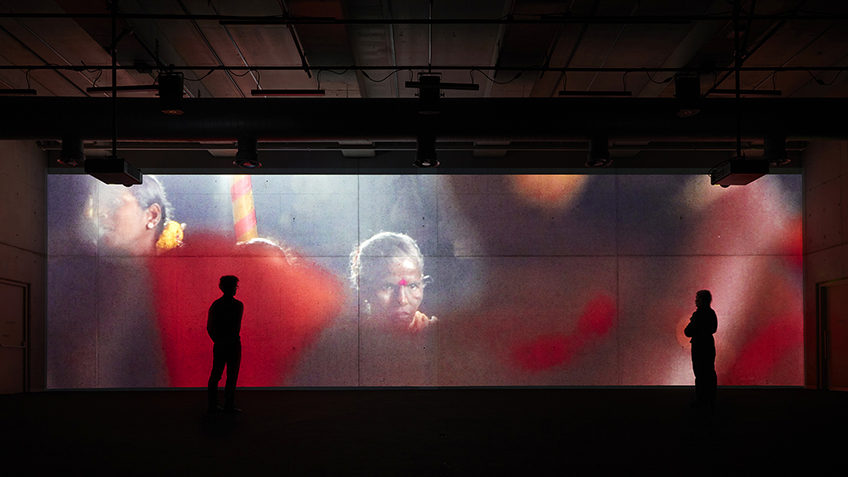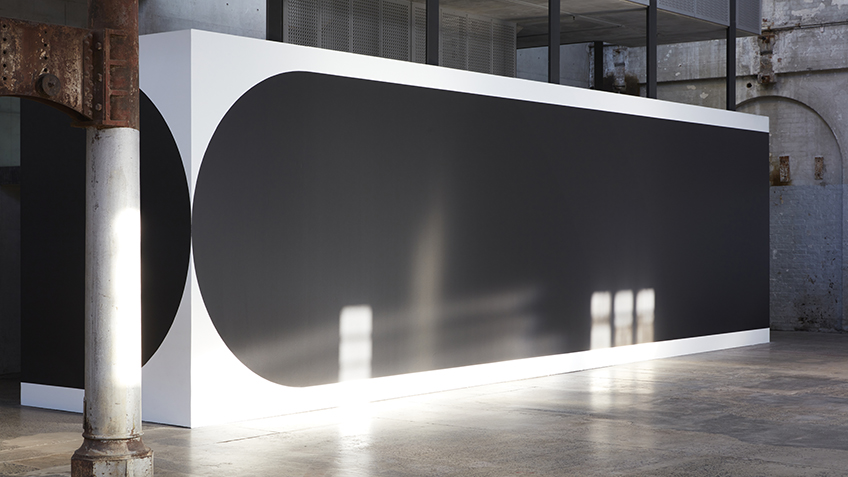Gigantic tuning forks, a centuries old ritual, subaquatic microearthquakes and geometric abstractions comprise Mel O’Callaghan’s latest body of work, presented for the first time at Carriageworks in the exhibition All is Life. If these subjects initially seem to have little in common, they are in fact all part of the artist’s extensive research into various means of transmission and communication. The four works on view—a video, a performance installation, a sound piece and a pair of wall paintings—impart messages that are each unique, but all interrelated. Bringing such diverse forms of transmission together, O’Callaghan’s exhibition can be seen as a kind of metaconversation. It also offers a transcendent communal experience, recalling social anthropologist Victor Turner’s description of ritual as, ‘an entire world of inanimate and animate entities, a population whose members are incessantly communicating with one another through every physical and mental instrumentality.’[1] At once deeply cerebral and surprisingly somatic, All is Life explores a wide range of communications—from tonal and geological to cultural and symbolic—with special attention to their individual and collective effects on the human body.
During the performance First sound, last sound (2022), soundwaves physically penetrate performers and spectators alike, creating perceptible vibrations within their bodies. To create this piece, O’Callaghan worked with a musicologist at the University of Sydney and Eveleigh Works (an industrial blacksmiths workshop located near Carriageworks) on the fabrication of two three-metre-tall steel tuning forks, each weighing 800 kilograms. Both forks are calibrated to 256 hertz, a deeply resonant tone. When one fork is struck, the vibration it emits causes the other fork to vibrate as well. This sympathetic response can also be described as a kind of ‘live’ echo whereby sound waves are not only being reflected, but newly generated. The dialogue between the forks (as initiated by the performers) is also intended to have a mental effect on all who are present. The pleasing sound of the 256 hertz tone, sometimes referred to as ‘the god note,’ is used in sound therapy techniques to induce a relaxed state of consciousness. By tapping into the body’s inner communication system (the nervous system), each performance of First sound, last sound is an opportunity for communal meditation.
Similarly corporeal, the sound work Pulse of the Planet (2022) harkens back to some of O’Callaghan’s earlier performances (Breath repertoire, 2018; Respire, respire, 2019; Pneuma, 2021) in which controlled breathing techniques alter the body’s physical and mental state. With her latest sound piece, O’Callaghan shifts focus to an arguably more powerful (certainly less easily directed) life force: the heart. Ensconced by the echoing percussion of a hydrophobic recording made by oceanographers near the centre of the earth, it is hard not to be hyper aware of the similarly rhythmic beating within one’s own chest. The earth’s life force thus becomes strangely palpable and personal. At once simple and astounding, Pulse of the Planet also underscores the notion of the earth as a giant living organism—a belief that goes back to ancient Greece, where Gaia was worshipped as a personification of the earth, and which still guides rituals performed by certain eco-feminist tribes in India.
One such ritual performed in Southern Goa in India is the subject of the video All is Life (2022). Filmed in Gaonkarwada, Ambaulim, a small village that is home to approximately 130 families, the video depicts select moments from the multi-day celebration of ‘Dhalo’. Every January Velip women perform Dhalo through dances, chants, performances and retellings of stories—all of which pay respect to the earth and serve to pass down traditions about living in harmony with nature. The video shows women chanting about local flora and fauna and sacred termite mounds in the forest. They are communing with nature and with each other; expressing gratitude to the earth while teaching a younger generation about Velip agricultural practices.
Dhalo is an ancient ritual that is performed year after year in villages in Goa and has never been recorded in Ambaulim. In close collaboration with the village and with special assistance from local Velip Kulmi journalist and poet Devidas Gaonkar, O’Callaghan has created a unique film that evokes the deep physical and spiritual connection between the Velip community and their forest environment. In addition to the footage captured on video, O’Callaghan’s visit to Ambaulim in January of 2022 led to many conversations and discussions, excerpts of which are included in the exhibition to provide more context.
The back-and-forth chanting captured in All is Life is visually echoed by a pair of black and white wall paintings collectively titled Call and Response (2022). Here, O’Callaghan uses abstract forms to illustrate another form of transmission. Painted in black on two white walls of Carriageworks’ soaring public space, two symmetrical oblong geometric shapes confront each other across an otherwise empty foyer. Suggesting greatly enlarged bits of Morse Code symbols or musical notations, the paintings ‘talk’ (or maybe even shout or sing) to each other in complete silence. This intentional quiet within the exhibition is an occasion to consider the possibility of communication without words or sound. The calm meditative moments in All is Life are surprisingly powerful, offering a way to get in touch with ourselves. As its title implies however, the exhibition nonetheless emphasizes collectivity and camaraderie. Capturing what performance studies professor Richard Schechner has described as the ‘second benefit’ of ritual whereby, ‘Individual and collective anxieties are relieved by rituals whose qualities of repetition, rhythmicity, exaggeration, condensation, and simplification stimulate the brain into releasing endorphins directly into the bloodstream…”[2] All is Life champions the joys of shared experiences.
Words by Mara Hoberman
Mara Hoberman is a Paris-based art critic and art historian. A regular contributor to Artforum, she is also currently conducting research for the forthcoming Joan Mitchell Catalogue Raisonné.
Visit Mel O’Callaghan’s All is Life at Carriageworks from 23 Jun – 21 Aug 2022, Wed-Sun from 10am – 5pm.




